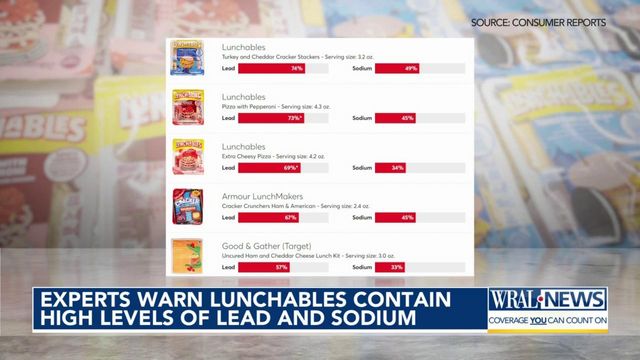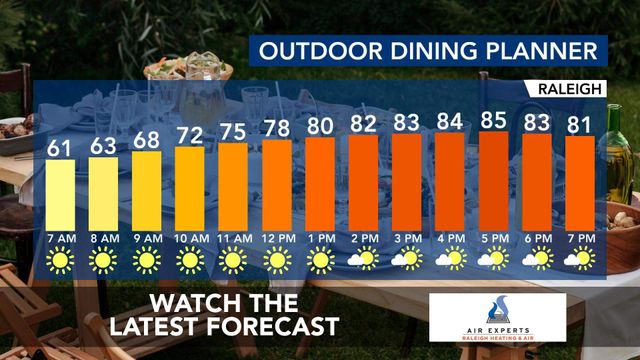Consumer Reports says Lunchables 'should not be allowed on menu' for schools, petitions USDA for removal
New York (CNN) — The school cafeteria versions of popular kids’ grocery store snack kit Lunchables is packed with too much sodium, a consumer watchdog group warned on Tuesday.
Lunchables developed two new versions of the snack kit specifically to be available nationally as part of school lunch programs for the first time last year. But a new report from Consumer Reports said it recently compared the nutritional profiles of two Lunchables kits served in schools and found they have even higher levels of sodium and lead than the Lunchables kits consumers can buy in stores.
"It's a relatively high amount of metal for a small amount of food," Kevin Loria, author of the report, said.
Roberson County Schools in North Carolina was one of the first schools to offer Lunchables in school cafeterias. A spokesperson for the school district told WRAL News schools stopped serving them in January, but did not explain why.
Consumer Reports said sodium levels in the store-bought lunch and snack kits it tested ranged from 460 to 740 milligrams per serving, or “nearly a quarter to half of a child’s daily recommended limit for sodium.” The group found that sodium levels in the turkey and cheddar school versions of Lunchables contained 930 mg of sodium compared to 740 mg in the store-bought version.
Consumer Reports said it tested 12 store-bought versions of Lunchables and similar ready-to-eat meal kits, including from Armour LunchMakers, Good & Gather, Greenfield Natural Meat Co. and Oscar Mayer, and also found lead, cadmium, or both in all, although none of the kits exceeded any federal limit. The testing also surfaced high levels of sodium in the other lunch kits.
Cadmium has been linked to kidney and bone disease and cancer, according to the World Health Organization. As natural elements, heavy metals such as lead and cadmium are in the soil in which crops are grown and thus can’t be avoided. Some crop fields and regions, however, contain more toxic levels than others, partly due to the overuse of metal-containing pesticides and ongoing industrial pollution.
Consumer Reports based their findings based on the California standards for lead content. There is no safe level of lead for children, however, according to the US Centers for Disease Control and Prevention.
WRAL's Five on Your Side checked with larger school districs in North Carolina, including Cumberland County Schools, Durham Public Schools and the Wake County Public School System, and none sell the Lunchables.
Lead bio-accumulates in the body, which means it stays and builds up over time, so ongoing exposure, even at extremely low levels, can become toxic. Children, especially infants, are particularly vulnerable because a smaller dose of lead can have a larger health effect on them compared with adults.
Loria said while an occasional Lunchables snack won't cause significant harm, the effects can build up over time.
Consumer Reports’ tests also detected at least one type of phthalate or phthalate replacement chemical in every kit it tested, except for Lunchables Extra Cheesy Pizza, it said. Lead and cadmium can cause developmental problems in children over time, even in small amounts.
Called “everywhere chemicals” because they are so common, studies have linked phthalates to childhood obesity, asthma, cardiovascular issues, cancer and reproductive problems such as genital malformations and undescended testes in baby boys and low sperm counts and testosterone levels in adult males.
The non-profit consumer group said it has petitioned the US Department of Agriculture, which oversees the federally assisted school meal program, to remove Lunchables food kits from school cafeterias, as a result.
“Lunchables are not a healthy option for kids and shouldn’t be allowed on the menu as part of the National School Lunch Program,” Brian Ronholm, director of food policy at Consumer Reports, said in a statement. “The Lunchables and similar lunch kits we tested contain concerning levels of sodium and harmful chemicals that can lead to serious health problems over time. The USDA should remove Lunchables from the National School Lunch Program and ensure that kids in schools have healthier options.”
Lunchables, made by Kraft Heinz, took its packaged ready-to-eat kids meals directly into K-12 school lunchrooms nationwide through the National School Lunch Program (NSLP) for the first time last year. The NSLP, established in 1946, provides lunch daily to nearly 30 million students in public and non-profit private schools and residential child care institutions.
But the company first had to re-formulate the ingredients to ensure the products met federal guidelines.
The rollout included two specially-created Lunchables options for schools (separate from Lunchables sold in grocery stores) – labeled “turkey and cheddar” and “extra cheesy pizza.” Kraft Heinz told CNN that the turkey and cheese option contains 6 grams of saturated fat and 930 milligrams of sodium while the extra cheesy variety contains 7 grams of saturated fat and 700 milligrams of sodium.
Kraft Heinz said both options were made using “a specialized recipe that incorporates more protein and whole grains to keep kids powered throughout the day, reduced saturated fat and sodium, and an increased serving size.”
The Lunchables pizza variety for schools (with 700 mg of sodium) compared to 510 mg in the store version. Eating foods with too much sodium can lead to high blood pressure and hypertension, Consumer Reports said.
The introduction of Lunchables in schools came amid proposed changes to school food guidelines by the USDA, which oversees the federally assisted school meal program. The proposed changes aimed to reduce added sugars and sodium levels in school-provided lunches. The standards would reduce sodium limits gradually over several school years.
The USDA sent the following statement to CNN and WRAL News:
"USDA takes very seriously our responsibility to ensure school meals are of the highest nutritional quality. This is why we have a new proposed rule which aims to align our programs with the latest nutrition science and modernize our services to best serve kids. Strengthening the nutrition of school meals comes from a common goal we all share: to help kids be healthy. Importantly, USDA doesn’t allow or disallow individual food items. Our requirements address the overall content of meals – some of them on a daily basis and others on a weekly basis. So, the Lunchables described in the article would need to be paired with fruit, vegetables and milk. In addition, a school who wanted to serve a higher sodium product one day has to balance that with lower sodium items on others."
Kraft Heinz told CNN in a statement Tuesday the company has taken steps to improve the nutrition profile of Lunchables. The effort, it said, includes launching Lunchables with fresh fruit, in partnership with Fresh Del Monte, and “reducing the sodium in all Lunchables crackers by 26%.”
“All our foods meet strict safety standards that we happily feed to our own families. We are proud of Lunchables and stand by the quality and integrity that goes into making them,” the company said.
Presence of additives
Consumer Reports also pointed to concerning additives included in many of the Lunchable products. Additives are ingredients added by manufacturers to stimulate appetite and extend shelf life.
The presence of additives is a key indicator of whether a food is ultraprocessed, said Carlos Monteiro, emeritus professor at the school of public health at the University of Sao Paulo, Brazil. In 2009 Monteiro created NOVA, a system of classifying food into categories from minimally processed to ultraprocessed.
“In terms of food processing, additives are essential to creating ultraprocessed foods,” Monteiro said. “Additives in ultraprocessed foods are those that use color, texture, flavor, and everything people like. So these products are made appealing not with real food, but with additives,” he said.
Such additives include preservatives to resist mold and bacteria; emulsifiers to keep incompatible ingredients from separating; artificial colorings and dyes; de-foaming, bulking and bleaching agents; and added or altered sugar, salt and fats intended to boost flavor to a “bliss point” that is hard to resist.
Food additives are considered “generally recognized as safe” (GRAS) by the US Food and Drug Administration, but not everyone agrees. Watchdog groups like the Center for Science in the Public Interest and the Environmental Working Group (EWG) provide lists of concerning chemicals found in food, as well as added sugars, salt and fats. A growing number of grocery stores and a few restaurants have also taken steps to ban worrisome chemicals from foods they sell.
According to ingredients listed on the Kraft-Heinz “Away from Home” website, CNN found the turkey and cheese Lunchables contains tertiary-butyl hydroquinone (TBHQ), a petroleum-based chemical found in pesticides. Studies have found TBHQ may lower immune response to flu and Covid-19 vaccines, may play various roles in the development of cancer, and may even alter DNA.
The Lunchables also contains the pesticide sodium diacetate, which adds sourness and fights fungus and bacteria, carrageenan, which has been shown to create inflammation and digestive issues in animals, and sodium nitrate, a preservative used in cured deli meats, hot dogs, bacon and sausage that has been linked to cancer and other diseases.
The-CNN-Wire™ & © 2024 Cable News Network, Inc., a Warner Bros. Discovery Company. All rights reserved.
WRAL News' Keely Arthur and Pritchard Strong contributed to this report.











